【Django】一对多表结构
2024-09-01 07:41:48
1.创建project数据库表
INSTALLED_APPS = [
'django.contrib.admin',
'django.contrib.auth',
'django.contrib.contenttypes',
'django.contrib.sessions',
'django.contrib.messages',
'django.contrib.staticfiles',
'app01', #新增app
]
配置settings.py
from django.db import models # Create your models here. class Business(models.Model):
# id 系统默认id列,自增,主键
caption = models.CharField(max_length=32) # 32表示字符长度 class Host(models.Model):
nid = models.AutoField(primary_key=True)
hostname = models.CharField(max_length=64,db_index=True)
ip = models.GenericIPAddressField(protocol='ipv4',db_index=True)
port = models.IntegerField()
b = models.ForeignKey(to='Business',to_field='id')
app01/models.py 创建两个简单的数据库表,通过ForeignKey外键关联
运行:
python manage.py makemigrations
python manage.py migrate
Ok后,使用Navicat Premium软件方可查看!
2.操作数据库表
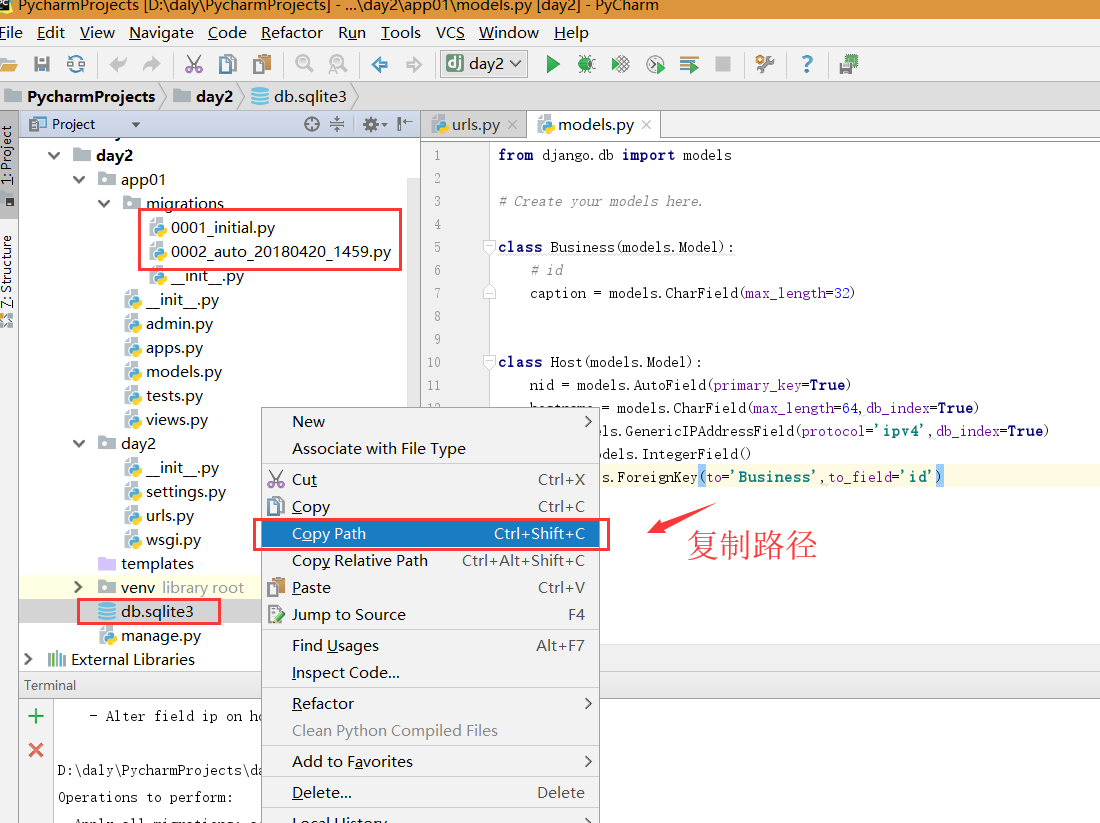
运行Navicat
点击连接,使用SQLite抓取数据
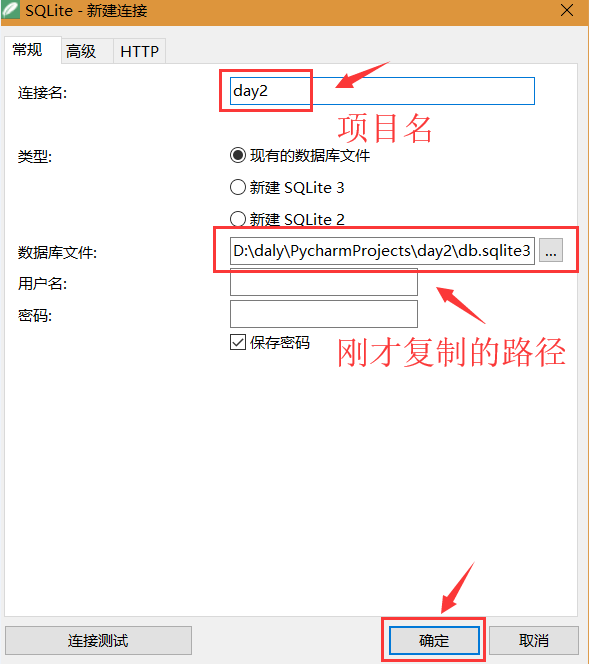
点击确认
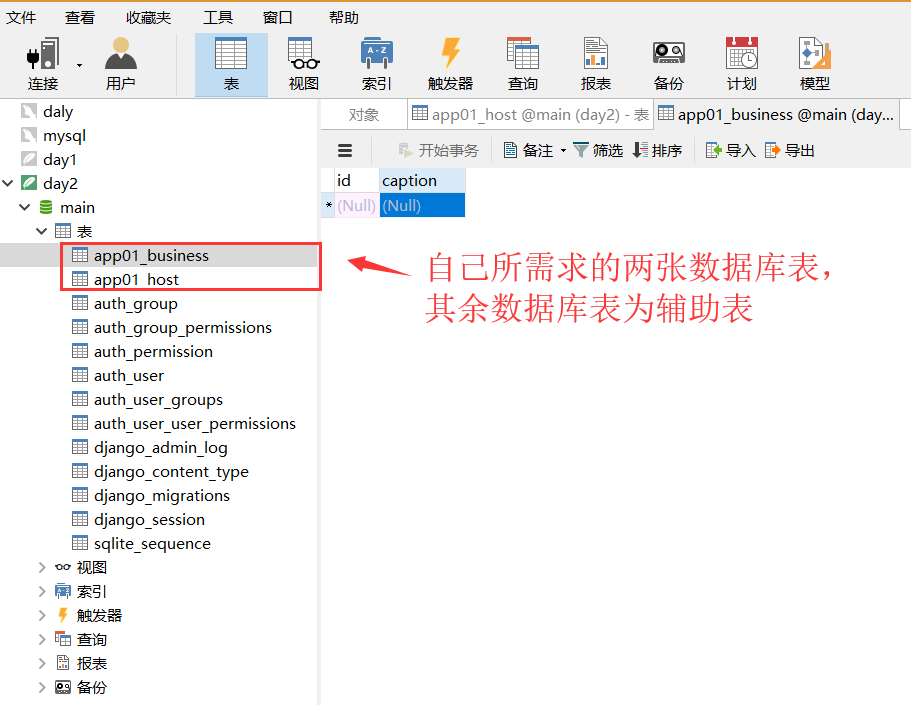
获取单表单数据的三种方式
from django.contrib import admin
from django.conf.urls import url
from app01 import views urlpatterns = [
url(r'^admin/', admin.site.urls),
url(r'^business/', views.business),
]
project/urls
from django.shortcuts import render,HttpResponse,redirect
from app01 import models
# Create your views here. def business(requset):
v1 = models.Business.objects.all()
#QuerySet
#[obj(id,caption,code),obj(id,caption,code),obj(id,caption,code)] v2 = models.Business.objects.all().values('id','caption')
# QuerySet
# [{'id':1,'caption':'苹果'},{'id':2,'caption':''香蕉},{'id':3,'caption':'菠萝'},{'id':4,'caption':'梨子'}] v3 = models.Business.objects.all().values_list('id','caption')
# QuerySet
# [(0,苹果),(2,香蕉)]
return render(requset,'business.html',{'v1':v1,'v2':v2,'v3':v3})
app01/views.py
from django.db import models # Create your models here. class Business(models.Model):
# id
caption = models.CharField(max_length=32)
code = models.CharField(max_length=32,null=True,default='apple')
app01/models.py
<!DOCTYPE html>
<html lang="en">
<head>
<meta charset="UTF-8">
<title>Title</title>
</head>
<body>
<h1>业务线列表(列表)</h1>
<ul>
{% for row in v1 %}
<li>{{ row.id }}-{{ row.caption }}-{{ row.code }}</li>
{% endfor %}
</ul>
<h1>业务线列表(字典)</h1>
<ul>
{% for row in v2 %}
<li>{{ row.id }}-{{ row.caption }}</li>
{% endfor %}
</ul>
<h1>业务线列表(元组)</h1>
<ul>
{% for row in v3 %}
<li>{{ row.0 }}-{{ row.1 }}</li>
{% endfor %}
</ul>
</body>
</html>
templates/business.html
效果图

一对多跨表操作(第一种)
from django.contrib import admin
from django.conf.urls import url
from app01 import views
# from django.urls import path urlpatterns = [
url(r'^admin/', admin.site.urls),
url(r'^business/', views.business),
url(r'^host/', views.host), #在business基础上
]
project/urls.py
from django.db import models # Create your models here. class Business(models.Model):
# id
caption = models.CharField(max_length=32)
code = models.CharField(max_length=32,null=True,default='apple') class Host(models.Model):
nid = models.AutoField(primary_key=True)
hostname = models.CharField(max_length=64,db_index=True)
ip = models.GenericIPAddressField(protocol='ipv4',db_index=True)
port = models.IntegerField()
b = models.ForeignKey(to='Business',to_field='id')
app01/models.py
from django.shortcuts import render,HttpResponse,redirect
from app01 import models
# Create your views here. def host(request):
v1 = models.Host.objects.filter(nid__gt=0)
#for row in v1:
#print(row.nid,row.hostname,row.ip,row.port,row.b_id,row.b.id,row.b.caption,row.b.code,sep='\t') # return HttpResponse('戴利祥')
return render(request,'host.html',{'v1': v1})
app01/views.py
<!DOCTYPE html>
<html lang="en">
<head>
<meta charset="UTF-8">
<title>Title</title>
</head>
<body>
<h1>业务线列表(列表)</h1>
<table border="">
<thead>
<tr>
<th>主机名字</th>
<th>IP</th>
<th>端口</th>
<th>业务线名称</th>
<th>业务线编码</th>
</tr>
</thead>
<tbody>
{% for row in v1 %}
<tr aa="{{ row.nid }}" ab="{{ row.b.id }}">
<td>{{ row.hostname }}</td>
<td>{{ row.ip }}</td>
<td>{{ row.port }}</td>
<td>{{ row.b.caption }}</td>
<td>{{ row.b.code }}</td>
</tr>
{% endfor %}
</tbody>
</table>
</body>
</html>
templates/host.html
效果图:
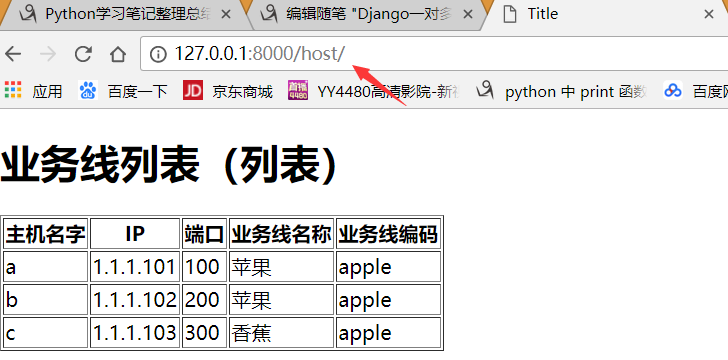
一对多跨表操作(第二种,第三种):
def host(request):
v1 = models.Host.objects.filter(nid__gt=0)
for row in v1:
print(row.nid,row.hostname,row.ip,row.port,row.b_id,row.b.id,row.b.caption,row.b.code,sep='\t') v2 = models.Host.objects.filter(nid__gt=0).values('nid','hostname','b_id','b__caption') #获取到的值为字典
# print(v2)
for row in v2:
print(row['nid'],row['hostname'],row['b_id'],row['b__caption']) v3 = models.Host.objects.filter(nid__gt=0).values_list('nid','hostname','b_id','b__caption') #获取到的值为元组
# #print(v3)
for row in v3:
print(row) # return HttpResponse('你好')
return render(request,'host.html',{'v1': v1, 'v2':v2 ,'v3':v3})
app01/views.py
print输出结果:
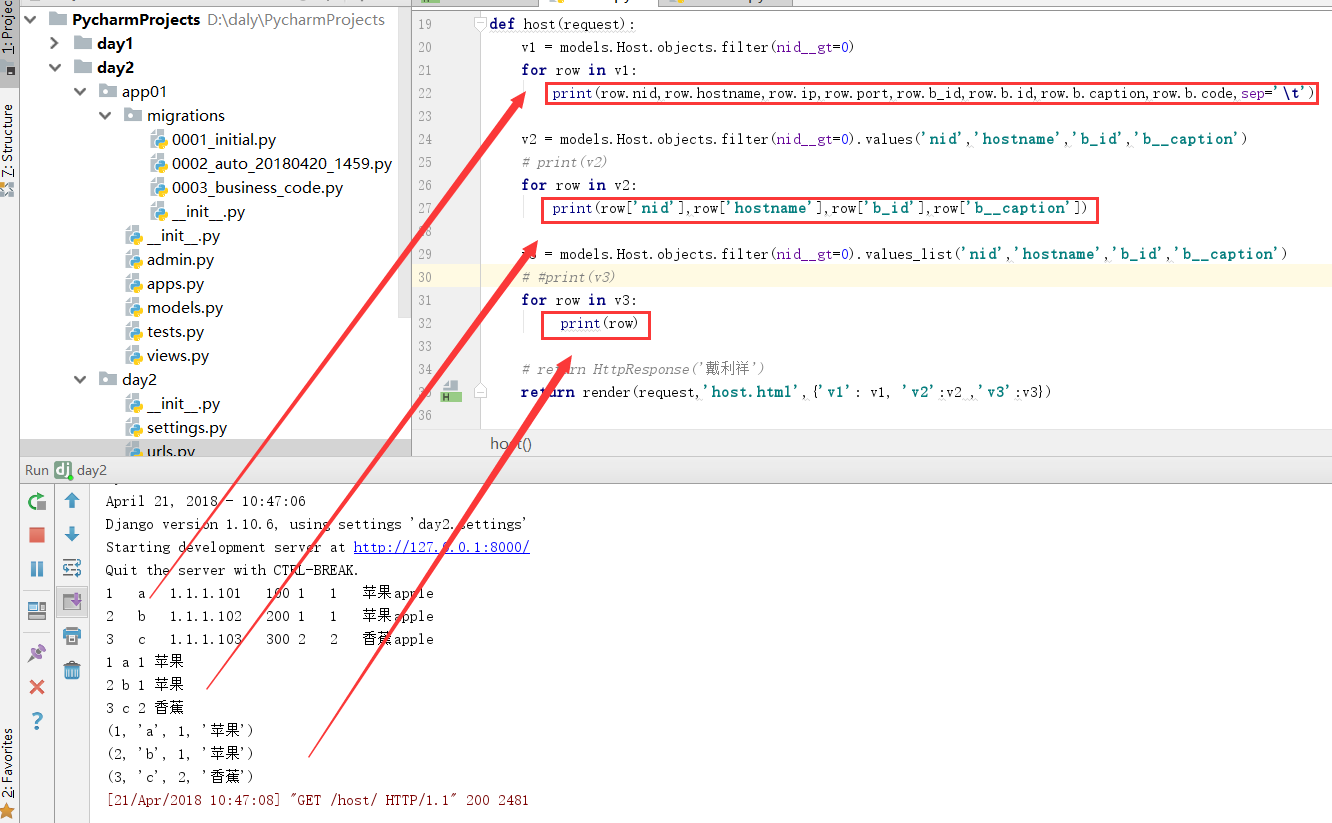
刷新:http://127.0.0.1:8000/host/

模拟对话框增加一对多数据示例
from django.shortcuts import render,HttpResponse,redirect
from app01 import models
# Create your views here. def business(requset):
v1 = models.Business.objects.all()
#QuerySet
#[obj(id,caption,code),obj(id,caption,code),obj(id,caption,code)] v2 = models.Business.objects.all().values('id','caption')
# QuerySet
# [{'id':1,'caption':'苹果'},{'id':2,'caption':''香蕉},{'id':3,'caption':'菠萝'},{'id':4,'caption':'梨子'}] v3 = models.Business.objects.all().values_list('id','caption')
# QuerySet
# [(0,苹果),(2,香蕉)]
return render(requset,'business.html',{'v1':v1,'v2':v2,'v3':v3}) def host(request):
if request.method == 'GET':
v1 = models.Host.objects.filter(nid__gt=0)
v2 = models.Host.objects.filter(nid__gt=0).values('nid','hostname','b_id','b__caption')
v3 = models.Host.objects.filter(nid__gt=0).values_list('nid','hostname','b_id','b__caption') b_list= models.Business.objects.all() return render(request,'host.html',{'v1': v1, 'v2':v2 , 'v3':v3 ,'b_list':b_list}) elif request.method == 'POST':
h = request.POST.get('hostname')
i = request.POST.get('ip')
p = request.POST.get('port')
b = request.POST.get('b_id')
# models.Host.objects.create(hostname=h,
# ip=i,
# port=p,
# b=models.Business.objects.get(id=b)
# )
models.Host.objects.create(hostname=h,
ip=i,
port=p,
b_id=b,
)
return redirect('/host') #以get分方式重新访问http://127.0.0.1:8000/host/
app01/views.py
<!DOCTYPE html>
<html lang="en">
<head>
<meta charset="UTF-8">
<title>Title</title>
<style>
.hide{
display: none;
}
.shade{
position: fixed;
top: 0;
right:0 ;
left: 0;
bottom: 0;
background: black;
opacity: 0.6;
z-index: 100;
}
.add-modal{
position: fixed;
height: 300px;
width: 400px;
top: 100px;
left: 50%;
z-index: 101;
border: 1px solid red;
background: white;
margin-left: -200px;
}
</style>
</head>
<body>
<h1>主机列表(列表)</h1>
<div>
<input id="add_host" type="button" value="添加"/> <!--模态对话框-->
</div>
<table border=""> <thead>
<tr>
<th>主机序号</th>
<th>主机名字</th>
<th>IP</th>
<th>端口</th>
<th>业务线名称</th>
</tr>
</thead>
<tbody>
{% for row in v1 %}
<tr aa="{{ row.nid }}" ab="{{ row.b.id }}" ac="{{ row.b.code }}">
<td>{{ forloop.counter }}</td>
<td>{{ row.hostname }}</td>
<td>{{ row.ip }}</td>
<td>{{ row.port }}</td>
<td>{{ row.b.caption }}</td>
</tr>
{% endfor %}
</tbody>
</table>
<h1>主机列表(字典)</h1>
<table border="">
<thead>
<tr>
<th>主机名字</th>
<th>业务线名称</th>
</tr>
</thead>
<tbody>
{% for row in v2 %}
<tr aa="{{ row.nid }}" ab="{{ row.b__id }}">
<td>{{ row.hostname }}</td>
<td>{{ row.b__caption }}</td>
</tr>
{% endfor %}
</tbody>
</table>
</table>
<h1>主机列表(元组)</h1>
<table border="">
<thead>
<tr>
<th>主机名字</th>
<th>业务线名称</th>
</tr>
</thead>
<tbody>
{% for row in v3 %}
<tr aa="{{ row.0 }}" ab="{{ row.2}}">
<td>{{ row.1 }}</td>
<td>{{ row.3 }}</td>
</tr>
{% endfor %}
</tbody>
</table> <div class="shade hide"></div> <!--遮罩层,全屏-->
<div class="add-modal hide"> <!--弹出框-->
<form method="POST" action="/host/"> <!--编辑弹出框内容-->
<div class="group">
<input type="text" placeholder="主机名" name="hostname"/>
</div> <div class="group">
<input type="text" placeholder="IP" name="ip"/>
</div> <div class="group">
<input type="text" placeholder="端口" name="port"/>
</div> <div class="group">
<select name="b_id">
{% for op in b_list %}
<option value="{{ op.id }}">{{ op.caption }}</option>
{% endfor %}
</select>
</div> <input type="submit" value="提交"/>
<input id="cancel" type="button" value="取消"/>
</form>
</div> <script src="/static/jquery-1.12.4.js"></script> <!--JS文件-->
<script>
$(function () { <!--页面框架加载完成--> $('#add_host').click(function () { <!--绑定事件-->
$('.shade,.add-modal').removeClass('hide'); <!--点击添加按钮,呼出遮罩层与弹出框-->
}); $('#cancel').click(function () {
$('.shade,.add-modal').addClass('hide');
}); })
</script>
</body>
</html>
templates/host.html
新增static/jquery-1.12.4.js 文件
https://files.cnblogs.com/files/dalyday/jquery-1.12.4.js
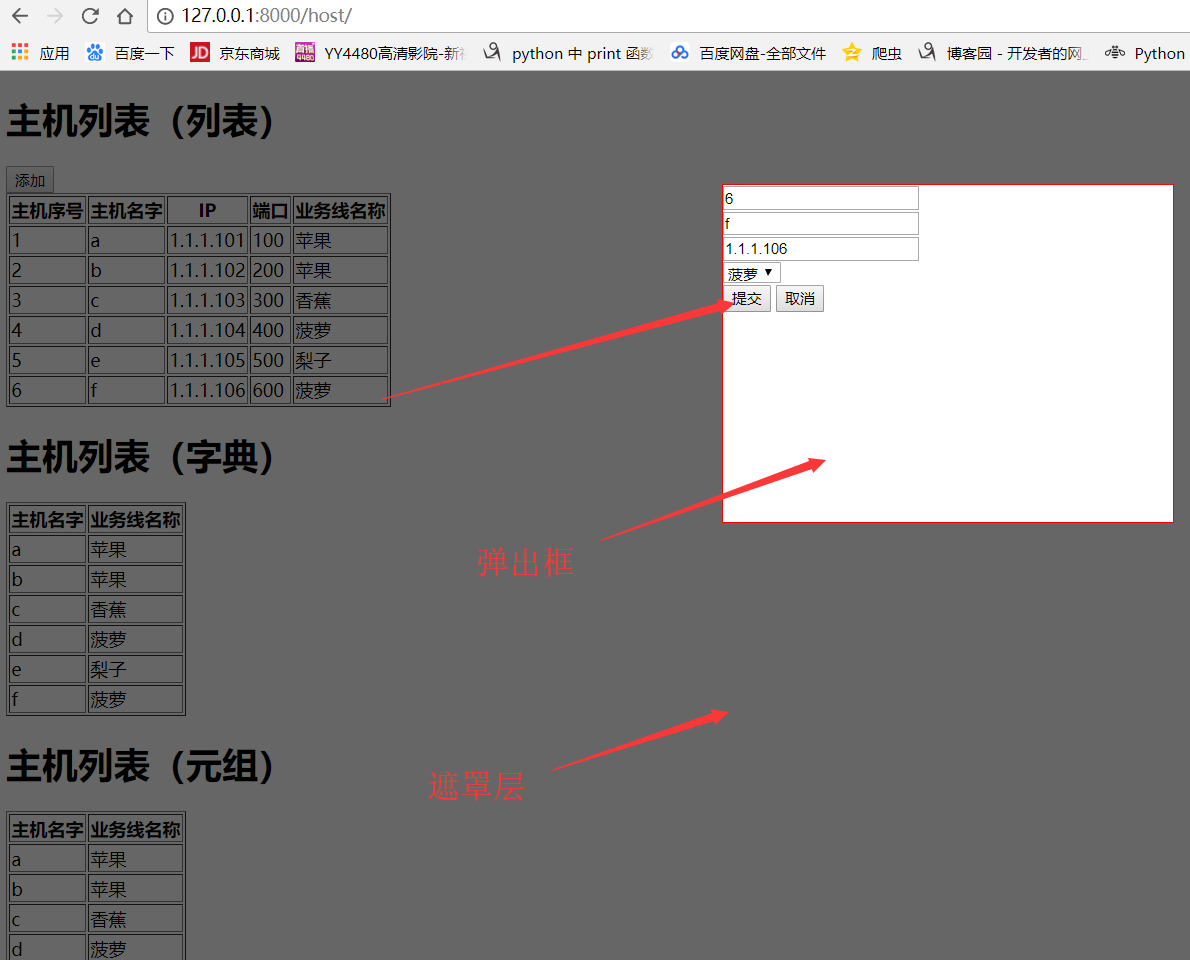
最新文章
- 【Python】 属性的 get 与 set 方法
- Html5-canvas
- sizeToFit()使用心得
- 【Java的JNI快速学习教程】
- android.annotation cannot be resolved
- 从零开始学习jQuery (八) 插播:jQuery实施方案
- Linux下产生随机密码10方法
- jQuery EasyUI的使用入门
- 刚由pc端做移动端的感受
- maximum shortest distance
- Hibernate异常之关键字错误
- 守护态运行Docker容器
- golang中的defer
- react-native 配置 在mac 上找不到.npmrc
- Oracle数据库ORA-01109 数据库未打开
- linux下搭建lamp环境以及安装swoole扩展
- 【WPF】ImageMagick调节图片的颜色
- iOS开发简记(3):tips提示
- Linux:磁盘配额
- Oracle安装部署之rhel 5.8下静默安装oracle11gr2
热门文章
- unity shader 纹理&透明效果
- Leetcode之二分法专题-1011. 在 D 天内送达包裹的能力(Capacity To Ship Packages Within D Days)
- MSIL实用指南-类相关生成
- Setup Factory 9 简单打包
- 使用GPU跑Tensorflow代码实录
- openSession 与 getCurrentSession的区别
- poj2186Popular Cows+tarjan缩点+建图
- Jmeter基础教程图文版(二)- 核心组件
- Loadrunner 11 的安装
- Python3-编码问题-解决为何我的python打印总是出现乱码??